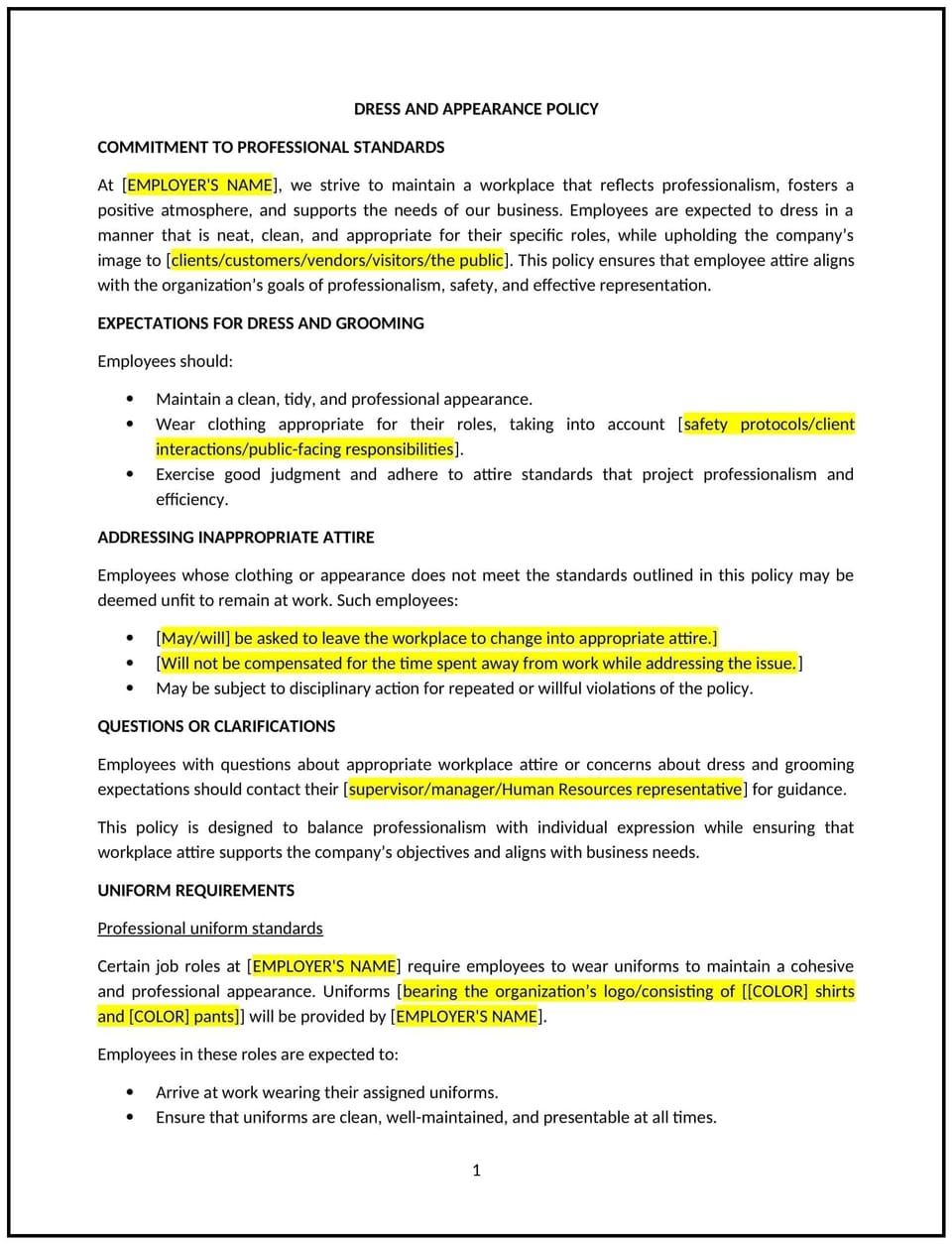Dress and appearance policy (Iowa): Free template

Dress and appearance policy (Iowa)
A dress and appearance policy helps Iowa businesses establish clear expectations for workplace attire while allowing flexibility based on job roles and company culture. Professional and appropriate dress contributes to a positive work environment, promotes brand consistency, and ensures employees represent the business effectively.
This policy outlines general dress code expectations, industry-specific requirements, and accommodations for religious or cultural attire. It provides businesses with a structured approach to maintaining professionalism while respecting individual expression.
By implementing this policy, businesses in Iowa can foster a cohesive workplace culture, enhance customer interactions, and ensure a balance between professionalism and comfort.
How to use this dress and appearance policy (Iowa)
- Define dress code expectations: Specify whether the workplace requires business formal, business casual, or casual attire based on job roles.
- Establish industry-specific guidelines: Outline attire requirements for positions that involve public interaction, safety considerations, or branding consistency.
- Allow for reasonable accommodations: Recognize religious, cultural, and disability-related attire needs.
- Address grooming and hygiene standards: Set expectations for neatness, cleanliness, and professional presentation.
- Provide uniform or branded clothing requirements: If applicable, require employees to wear company-issued attire or name tags.
- Outline restrictions on inappropriate attire: Specify clothing types that may not be suitable for the workplace, such as offensive graphics, overly casual wear, or unsafe footwear.
- Set seasonal and special event guidelines: Allow flexibility for weather-related dress adjustments or themed business events.
- Review and update: Regularly assess the policy to align with company branding, workplace culture, and employee feedback.
Benefits of using this dress and appearance policy (Iowa)
This policy offers several advantages for Iowa businesses:
- Promotes a professional workplace: Establishes clear expectations for appropriate dress.
- Enhances brand representation: Ensures employees present a consistent image to clients and customers.
- Improves workplace safety: Defines appropriate attire for specific job roles and environments.
- Encourages inclusivity: Allows accommodations for religious, cultural, and medical considerations.
- Reduces misunderstandings: Provides employees with clear guidelines to prevent dress code violations.
- Supports a positive work environment: Balances professionalism with employee comfort and individuality.
Tips for using this dress and appearance policy (Iowa)
- Tailor dress code expectations to roles: Businesses should set different guidelines for office staff, customer-facing roles, and fieldwork positions.
- Allow reasonable flexibility: Businesses should provide options for employees to express individuality within professional limits.
- Communicate policy changes clearly: Businesses should inform employees in advance of any dress code updates.
- Set clear enforcement procedures: Businesses should outline how dress code violations will be addressed and provide corrective action steps.
- Consider employee feedback: Businesses should periodically review policies based on workplace culture and employee preferences.
- Balance professionalism and comfort: Businesses should ensure that dress codes are practical, especially for roles that require movement or outdoor work.
Q: Why should Iowa businesses implement a dress and appearance policy?
A: Businesses should establish this policy to create a professional work environment, maintain brand consistency, and set clear expectations for employee attire.
Q: How should businesses determine dress code expectations?
A: Businesses should consider industry standards, customer interactions, safety requirements, and company culture when setting guidelines.
Q: Can employees request accommodations for religious or cultural attire?
A: Yes, businesses should allow reasonable accommodations for religious, cultural, or disability-related dress needs.
Q: What should businesses do if an employee violates the dress code?
A: Businesses should address violations through private discussions, provide guidance on expectations, and take corrective action if needed.
Q: How often should businesses review their dress and appearance policy?
A: Businesses should assess the policy annually to reflect workplace culture, branding needs, and industry trends.
Q: Can businesses require employees to wear uniforms?
A: Yes, businesses should specify uniform requirements and whether employees are responsible for purchasing or maintaining them.
Q: Should businesses allow casual dress days?
A: Businesses should decide whether to allow casual dress days and communicate expectations for appropriate attire on those days.
Q: How can businesses enforce dress codes fairly?
A: Businesses should apply dress code policies consistently across all employees and provide clear guidelines to avoid subjective enforcement.
This article contains general legal information and does not contain legal advice. Cobrief is not a law firm or a substitute for an attorney or law firm. The law is complex and changes often. For legal advice, please ask a lawyer.


